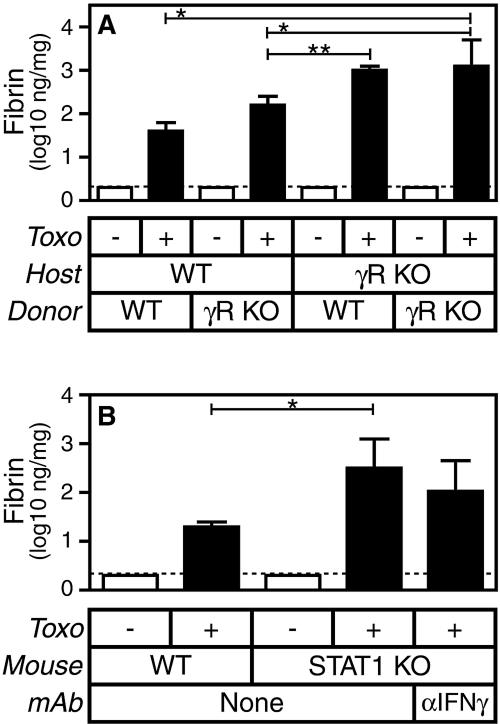FIG. 6.
The suppression of fibrin deposition by IFN-γ during acute T. gondii infection (Toxo) is STAT1 dependent and primarily mediated by IFN-γR (γR) expressed by radioresistant cells. (A) Bone marrow chimeras were generated from WT and IFN-γR-deficient mice, as indicated. After reconstitution, mice were sham infected (open bars) or infected perorally with 10 ME49 T. gondii cysts (closed bars). Levels of hepatic fibrin were measured on day 8 after the initiation of infection. Data depict the median and interquartile range (n = 10 mice per group). The dashed line depicts the limit of detection. WT hosts reconstituted with either WT or IFN-γR-deficient bone marrow produce significantly less fibrin than IFN-γR-deficient hosts reconstituted with IFN-γR-deficient bone marrow (*, P < 0.001). By contrast, IFN-γR-deficient hosts produce similar levels of fibrin, regardless of whether they are reconstituted with WT or IFN-γR-deficient bone marrow. Among the mixed chimeras, WT hosts reconstituted with IFN-γR-deficient bone marrow produce significantly less fibrin than did IFN-γR-deficient hosts reconstituted with WT bone marrow (**, P < 0.01). (B) WT and STAT1-deficient mice were sham infected (open bars) or infected perorally with 10 ME49 T. gondii cysts (closed bars). Where indicated, STAT1-deficient mice were treated with IFN-γ-specific MAb 1 day prior to infection. Levels of hepatic fibrin were measured on day 8 after the initiation of infection. Data depict the median and interquartile range (n = 15 mice per group, except for n = 5 for mice treated with IFN-γ-specific MAb). The dashed line depicts the limit of detection. T. gondii-infected STAT1-deficient mice produce significantly more fibrin than WT mice (P < 0.0001) but do not further increase levels of fibrin upon treatment with IFN-γ-specific MAb. KO, knockout. RU, relative units.

